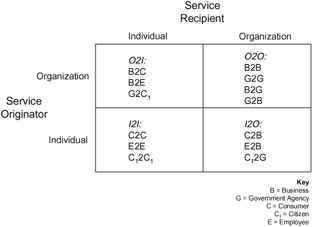The Trust Context: Digital Era Interactions
There are multiple potential players in any digital interaction. These include businesses, governments, and individuals as consumers or citizens. Concentrating initially on businesses and consumers, and taking each combination of business (B) and consumer (C), leads to four e-business configurations. Business-to-consumer (B2C) is perhaps the most visible and well-known, exemplified by Web-based businesses (such as Amazon.com) that sell goods and possibly services to the final customer, or 'consumer'. The business-to-business (B2B) market is much larger in transaction value terms than B2C. Although B2B transactions can be conducted via e-marketplaces by human operators, there is a step change when B2B automation is introduced. Here, it is not human-computer interaction but machine-to-machine interaction where information systems communicate and negotiate with each other, typically using XML-based industry standards for data and Web service standards for invocation (see, for example, Hagel's (2002) description of Dell's Web service-based management of its supply chain). Consumers can interact with consumers (C2C) and conduct transactions, as they do on auction sites such as eBay. Customers can also create opinion online through sites such as epinions.com and dooyoo.com, as well as interacting in virtual communities (e.g., FriendsReunited) and sharing resources in peer-to-peer networks (e.g., Napster derivatives such as Kazaa). Finally, in the consumer to business (C2B) model, customers can get together to buy and use the Web to aggregate demand in order to get more leverage with businesses (e.g., letsbuyit.com) or to make individual offers to firms (e.g., priceline.com).
In Figure 1 each of the four e-business forms is represented in terms of a service originator and service recipient. The generalization of 'Business' to 'Organization' allows for further types of organizations to be incorporated, such as governmental agencies. Similarly, generalizing consumer to individual introduces two further categories: citizens and employees. Some of the resulting combinations, such as citizen to government, may not yet exist in any tangible form, but the DEI matrix in Figure 1 indicates areas where digital era developments might be expected with consequent implications for trust. Thus, although the I2O quadrant is currently the least developed of the four, it may prove to be an interesting sector in the longer term. As discussed, C2B is a growing area for e-commerce, allowing consumers to organize themselves and use their stronger bargaining power to obtain a better price. By analogy, employees can organize themselves to put pressure on their employer to negotiate wage settlements (this used to be the role of the unions) and citizens could organize to indicate to government how they want their tax revenues spent. The matrix is not exhaustive (for example, it does not include E2C, employee to consumer), but it does cater for the principal electronic relationships that currently exist and highlights ones that will be significant in the future.

Figure 1: Digital Era Interactions (DEIs)
EAN: 2147483647
Pages: 198